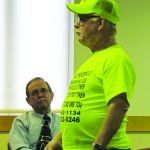West Virgina. Many may think is filled with hicks and trailer trash, but that is only the stereotype that people cast over the state. West Virginia is known for the industry known as coal mining.
There are many who do not know much about coal mining, let alone that there are two different types of coal mining that is done in the state of West Virginia.
Larry Gibson, founder of “Keeper of the Mountains,” spoke to the Cabrini College community on Thursday, March 11 about the environmental and human rights issue of coal mining that occurs at the top of his home in West Virginia.
Gibson, who had 310 years of family history on Kayford Mountain in West Virginia located near Cabin Creek, has seen his family history destroyed.
Every day Gibson stands on top of his mountain, protecting his home from being destroyed by coal companies. Originally, there was conventional mining, when the coal miners extract the coal from the mountain by going through the mountain in a mine. But now in West Virginia, there is surface mining, also known as mountaintop removal.
Mountaintop removal is described on a pamphlet from Gibson’s Web site Ilovemountains.org as “a radical form of coal mining in which entire mountains are literally blown up. After the coal is retrieved, the earth from the mountaintop is dumped in neighboring valleys.”
Students and staff on last year’s Project Appalachia trip were able to go up with Gibson and see mountaintop removal first hand.
“The first time going up the mountain with Larry was shocking,” Joe Kimpflen, senior history and political science major, said. “When I heard Larry again, I remembered some of the emotions I originally felt.”
The Cabrini students were able to find out about this hidden crisis in West Virginia and go past what is known as “hell’s gate.” Past “hell’s gate” all the students would hear were the trucks and the beeping of the mountain just about to be blown away.
“Larry pointed out where children used to play and go to school, where birds sang, and families lived. Today, that is all gone, as Larry pointed out. It was hard to believe that the mountain was a happy place, when the entire group saw bareness. I felt like I was on another planet,” Lindsay Anderson, sophomore exercise science and health promotion major, said.
“I’m not just against Mountain Top Removal,” Gibson said. “I’m against coal mining in general. After I came back from West Virginia after being gone for 29 years I said ‘My goodness there is destruction in one of your states and none of ya’ll seem to care.’ So I got involved and I did something.”
Gibson has had over 100 death threats, has had his two dogs shot and killed and saw his family cemetery of over 300 years be bulldozed down the side of the mountain by coal miners.
Each year the coal companies lose up to 300-400 people to coal. It’s because they are breathing in the air and the dust from the coal, which causes the deadly disease known as black lung disease. People develop this disease depending on how long they have been around the coal. The carbon and silica that is in the coal is one of the big factors as to why people get black lung disease. The common symptoms are shortness of breath, obstruction of airways and severe cough. Black lung disease my cause strain on the right side of the heart eventually causing heart failure and some patients may develop emphysema.
“Since 1993 we have 550 people, 550 people to one damn industry. Who can okay that? How can that be acceptable,” Gibson said. “Last year we lost 11 miners in the country. Coal companies say that surface mining is safer then conventional mining. Last year seven out 11 of the miners were surface miners that got killed.”
But it is not just the coal miners who are breathing in this air. Everything around Gibson is poisoned. In 2003, a Programattic Environmental Impact Statement said that mountaintop removal has “buried and contaminated more than 1,200 miles of streams in Appalachia. This means that every time Gibson wants a glass of water, he can’t drink it because of the contamination. Every time Gibson wants to bathe in a proper shower, he can’t. Still Gibson stands against the coal companies refusing to let them destroy his childhood.
“I do not want to sell my culture, my history for somebody to destroy it,” Gibson said.
Gibson wanted to get through to people and let people know about mountaintop removal. He wanted to leave an impact on the students because according to Gibson he only has one chance to get through to the people.
“Larry was so honest and his emotions came through when he spoke about the issue,” Kimpflen said. “His talk was so descriptive that it was hard not to imagine the devastating effects mountaintop removal is having on the Appalachian Region.”
“What inspires me most about Larry is his determination. His passion against mountaintop removal is so strong and loud, that his voice is hard to miss. He makes one want to listen and take action,” Anderson said.
Every day, Gibson travels up to the top of Kayford Mountain with a gun nearby, a camera and a radio system to hear what the truck drivers of the coal companies say about him. He goes around to other universities and talks about what he is advocating for.
“Often times I give these talks, I try to get through to them because I simply want to get my point across,” Gibson said. “The price is too high. We now in the United States, young educated people keep hearing about third world countries. Well have you read about the third world country in your own country called Appalachia. Have you really checked in to it? For those that come to see me God bless ya, but when you come, don’t just leave. I want people to know what has been happening in the Appalachia coalfield. This is the best kept dirty secret.”
“What if it came into your backyard tomorrow? What would you do?” Gibson said. “If you don’t stand up for what you believe in, you will lose.”




